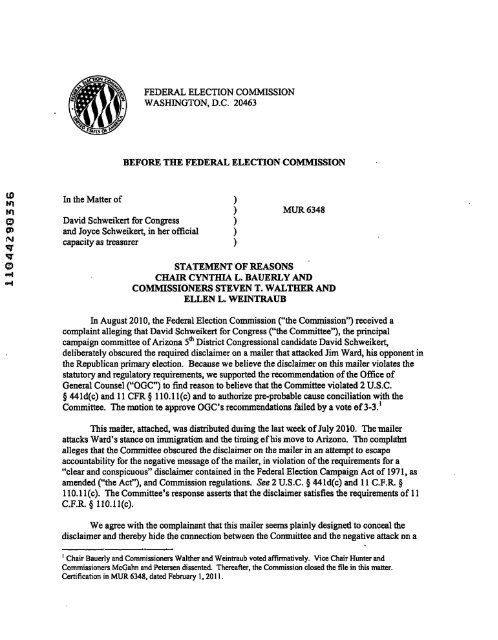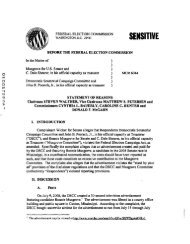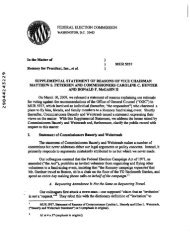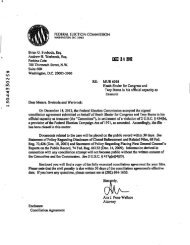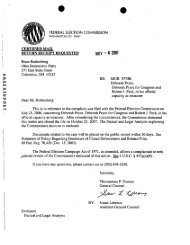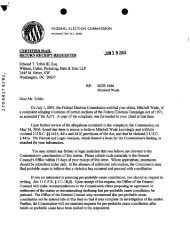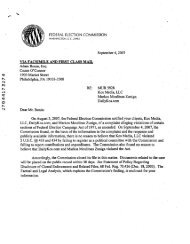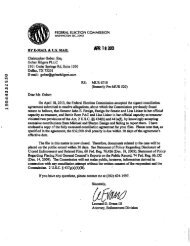Statement of Reasons
Statement of Reasons
Statement of Reasons
You also want an ePaper? Increase the reach of your titles
YUMPU automatically turns print PDFs into web optimized ePapers that Google loves.
In the Matter <strong>of</strong><br />
FEDERAL ELECTION COMMISSION<br />
WASHINGTON, D.C. 20463<br />
BEFORE THE FEDERAL ELECTION COMMISSION<br />
David Schweikert for Congress<br />
and Joyce Schweikert, in her <strong>of</strong>ficial<br />
capacity as treasurer<br />
\ MUR 6348<br />
STATEMENT OF REASONS<br />
CHAIR CYNTHU L. BAUERLY AND<br />
COMMISSIONERS STEVEN T. WALTHER AND<br />
ELLEN L. WEINTRAUB<br />
In August 2010, the Federal Election Commission ("the Commission") received a<br />
complaint alleging that David Schweikert for Congress ("the Committee"), the principal<br />
campaign committee <strong>of</strong> Arizona 5* District Congressional candidate David Schweikert,<br />
deliberately obscured the required disclaimer on a mailer that attacked Jim Ward, his opponent in<br />
the Republican primary election. Because we believe the disclaimer on this mailer violates the<br />
statutory and regulatory requirements, we supported the recommendation <strong>of</strong> the Office <strong>of</strong><br />
General Counsel ("OGC") to find reason to believe that the Committee violated 2 U.S.C.<br />
§ 441d(c) and 11 CFR § 110.11(c) and to authorize pre-probable cause conciliation with tfae<br />
Committee. The motion to approve OGC's recommendations failed by a vote <strong>of</strong> 3-3.'<br />
This mailer, attached, was distributed during the last week <strong>of</strong> July 2010. The mailer<br />
attacks Ward's stance on immigration and the timing <strong>of</strong>his move to Arizona. The complaint<br />
alleges that the Committee obscured the disclaimer on the mailer in an attempt to escape<br />
accountability for the negative message <strong>of</strong> the mailer, in violation <strong>of</strong> the requirements for a<br />
"clear and conspicuous" disclaimer contained in the Federal Election Campaign Act <strong>of</strong> 1971, as<br />
amended ("the Act"), and Commission regulations. See 2 U.S.C. § 441d(c) and 11 CF.R. §<br />
110.11(c). The Committee's response asserts that the disclaimer satisfies tiie requirements <strong>of</strong> 11<br />
C.F.R.§ 110.11(c).<br />
We agree with the complainant that this mailer seems plainly designed to conceal the<br />
disclaimer and thereby hide the connection between the Committee and the negative attack on a<br />
' Chair Bauerly and Commissioners Walther and Weintraub voted affirmatively. Vice Chair Hunter and<br />
Commissioners McGahn and Petersen dissented. Thereafter, the Commission closed the file in this matter.<br />
Certification in MUR 6348, dated February 1,2011.
MUR 6348 (David Schweikert for Congress, et al.)<br />
<strong>Statement</strong> <strong>of</strong> Chair Bauerly and Commissioners Walther and Weintraub<br />
Page 2 <strong>of</strong>4<br />
campaign opponent. Candidates have a right to distribute campaign advertisements, including<br />
negative attacks on their opponents. The public also has a right to know who is responsible for<br />
such advertisements. The public should not be required to engage in a game <strong>of</strong> "Hide-and-Seek"<br />
to discover the disclaimer on campaign materials.<br />
All public communications made by a political committee must include disclaimers. 2<br />
U.S.C § 441d; 11 C.F.R. § 110.11(a)(1). Any communication through mass mailing paid for by<br />
a candidate or an authorized political committee <strong>of</strong> a candidate must clearly state that the<br />
communication has been paid for by that committee. 2 U.S.C § 441d(a); 11 CF.R. §<br />
llO.ll(b).^<br />
The mailer contains the disclaimer "Paid for by Schweikert for Congress" printed<br />
sideways in small amber type on the upper right side <strong>of</strong>the mailer over a photograph <strong>of</strong> San<br />
Francisco viewed firom the Golden Gate Bridge. The disclaimer meets some <strong>of</strong> the requirements<br />
<strong>of</strong> the Act and Commission regulations - it states that it is paid for by Schweikert for Congress,<br />
it is printed in what appears to be 12-point font, and it is contained in a printed box. See 2 U.S.C.<br />
§ 441d(c); 11 C.F.R. § 110.11(c). However, the disclaimer fails to meet other requirements <strong>of</strong><br />
the Act and Commission regulations. These requirements are not onerous.<br />
First, the disclaimer is not printed with the required "reasonable degree <strong>of</strong> color contrast<br />
between the background and the printed statement." 2 U.S.C § 441d(c)(3). Other text in the<br />
mailer is printed in black or bold red type with white shadow setting <strong>of</strong>f the text from the yellow<br />
background. The disclaimer in contrast is printed in amber type over a multi-colored<br />
photograph, causing some <strong>of</strong> the printing to blend in with the background. The amber print <strong>of</strong><br />
the disclaimer is difficult to read over the dark blue <strong>of</strong> the water, the light and dark city<br />
buildings, and the dark blue <strong>of</strong> the sky in the photograph.<br />
Second, the disclaimer is not "contained in a printed box set apart firom the other contents<br />
<strong>of</strong> the communication." 2 U.S.C. § 441d(c)(2). The outiine <strong>of</strong> the box around the disclaimer is<br />
printed to line up with the cables <strong>of</strong> the bridge in the background photograph, making the box<br />
quite difficult to distinguish from the background. The failure to set the box apart is particularly<br />
significant since the disclaimer itself blends in with the background photograph, making it even<br />
more difficult to catch one's eye.<br />
^ Public communications include any mass mailing to the general public or any other form <strong>of</strong> general public political<br />
advertising. 11 C.F.R. § 100.26. A mass mailing is defined as more than 500 pieces <strong>of</strong> substantially similar mail<br />
within any 30-day period. 2 U.S.C. § 431(23); 11 CF.R. § 100.27. Although the complaint and the response do not<br />
address the number <strong>of</strong> mailers distributed, the Committee's disclosure reports include contemporaneous payments to<br />
printing vendors ranging from approximately $5,000 to $26,000. It is thus likely that the Committee distributed<br />
over 500 mailers, and, therefore, that the disclaimer requirements apply. If the Commission were to find reason to<br />
believe a violation occurred and authorize pre-probable cause conciliation, and during the course <strong>of</strong> conciliation<br />
respondents produced information demonstrating that fewer than 500 mailers were distributed, the Commission<br />
would drop the matter at that time.
MUR 6348 (David Schweikert for Congress, et al.)<br />
<strong>Statement</strong> <strong>of</strong> Chair Bauerly and Commissioners Walther and Weintraub<br />
Page 3 <strong>of</strong> 4<br />
Third, "[a] disclaimer is not clear and conspicuous if it is difficult to read or hear, or if the<br />
placement is easily overlooked." 11 C.F.R. § 110.11(c)(1). The disclaimer is difficult to find<br />
and read because it is printed sideways - perpendicular to all the other text in the mailer - on the<br />
upper right side <strong>of</strong> the mailer and blends in with the background photograph. Indeed, its<br />
placement within the bridge cables makes it very easy to overlook.<br />
Finally, neither <strong>of</strong> the safe harbor standards for color contrast in the regulations is met<br />
because the disclaimer is not printed in black text on a white background and the largest text in<br />
the communication is printed at a much higher contrast from the background color. 11 C.F.R.<br />
§ 110.11(c)(2).<br />
This matter falls into a different category fiom previously dismissed enforcement matters<br />
involving disclaimers. The Commission has dismissed enforcement matters in cases <strong>of</strong> omitted<br />
disclaimers due to inadvertent error followed by prompt remedial action or in cases in which the<br />
public could reasonably discern who was responsible for the advertisement fiom other<br />
information on the materials. See, e.g., MUR 6316 (Pridemore for Congress) (Commission<br />
dismissed matter where a committee failed to include appropriate disclaimers on campaign<br />
materials but took prompt remedial action); MUR 6118 (Bob Roggio for Congress) (same);<br />
MUR 6329 (Michael Grimm for Congress) (same); MUR 6278 (Joyce B. Segers) (Commission<br />
dismissed matter where a committee failed to include a disclaimer on campaign materials but the<br />
public could reasonably discern that the committee produced the information from its contents<br />
and the committee took remedial action). The facts presented in these four MURs are not<br />
present here. Without a "clear and conspicuous" disclaimer on the mailer here, the public had no<br />
other way <strong>of</strong> knowing who was responsible for the mailer, since the mailer does not make any<br />
other reference to Schweikert or the Committee and only mentions the opponent it is attacking.<br />
In this case, not only does the disclaimer fail to meet the requirements <strong>of</strong>the Act and<br />
regulations, but it appears that the Committee intentionally designed the mailer to make the<br />
disclaimer difficult to locate and read. There is plenty <strong>of</strong> blank space on the mailer where the<br />
disclaimer could have been put. Furthermore, there is a large amount <strong>of</strong>other text on the mailer<br />
that is "clear and conspicuous." The only thing that is "conspicuous" about the disclaimer,<br />
however, is that it is conspicuously difficult to locate and read. We do not believe a dismissal is<br />
appropriate under such circumstances. We believe that to vote against "reason to believe" under<br />
the facts <strong>of</strong> this case ignores both the plain language and the spirit <strong>of</strong> the Act's disclaimer<br />
requirements.
KI<br />
MUR 6348 (David Schweikert for Congress, et al.)<br />
<strong>Statement</strong> <strong>of</strong> Chair Bauerly and Commissioners Walther and Weintraub<br />
Page 4 <strong>of</strong> 4<br />
We agree with the General Counsel's recommendation to open settlement negotiations<br />
with a low penalty <strong>of</strong>fer. Nonetheless, in this case, and in cases like this in the future, the public<br />
has a right to know who is responsible for advertisements like this mailer. We fear that without<br />
enforcement <strong>of</strong> the Act's disclaimer requirements in this case, the opportunity for such<br />
knowledge is substantially diminished. For this reason, we voted to find reason to believe that<br />
the Committee violated 2 U.S.C. 441d(c) and 11 CFR § 110.11(c).<br />
Q Date ate ' Cvntnia CyntUia L. Bauei Bauerl<br />
Chair<br />
Date Steven T. Walther<br />
Commissioner<br />
Datfe Ellen L. Weintraub '<br />
Commissioner


